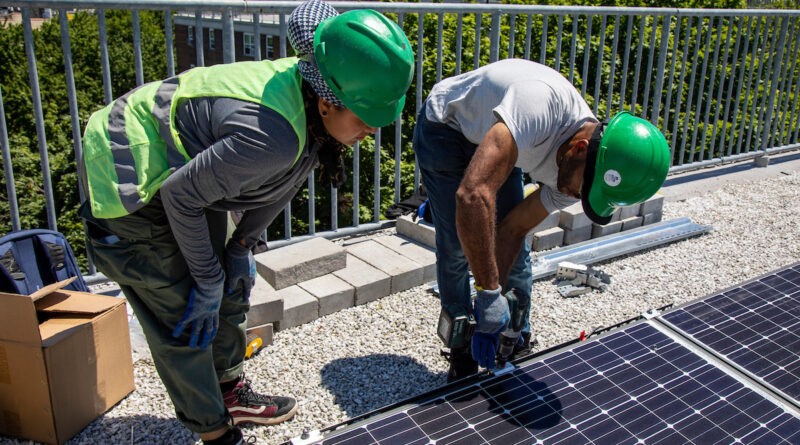On-site Clean Power Generation & Battery Storage

Description
- Onsite clean power generation is the production of clean energy (solar, wind, hydro, among others) at the site where it is to be consumed. It is a form of decentralized energy generation that often substitutes or complements the energy received through the utility grid. The ideal siting for solar installations it’s in areas with difficult distribution e.g., rural, or areas with high-dependency on fossil fuel-based power generation e.g., New York City. In addition, solar PV system hosts require sunlight exposure; reason why NYCHA’s footprint size makes it an ideal for solar generation within NYC.
- The elements for Onsite clean power generation are:
- Solar array, which is a group of interconnected solar panels, each panel has a group of cells
- Inverter, which transforms DC electricity into AC (for either building use or to the grid)
- Meter, indicates power consumption and that is received/transferred to the grid
- Battery for storing the power generated by the PV system
- Onsite Clean Power Generation can either:
- Serve directly the grid, for which it does not need a battery
- Serve the site where it is installed, for which it would need a battery
- Serve both, the site and the grid, and would need a battery
- Of the three options listed above, NYCHA currently has a program (ACCESSolar) for number 1. The other two uses of solar PV systems require a battery which is known as Battery Energy Storage Systems, or BESS. These are rechargeable batteries that store energy from different sources –ideally from clean sources like solar- and discharge it when needed. BESS consists of one or more batteries used to balance the electric grid, provide backup power, and improve grid stability. BESS can serve multiple purposes:
- Resiliency or Emergency Generation: means a secondary source of electrical power whenever the primary energy supply is disrupted or discontinued during power outages or natural disasters that are beyond the control of the owner or operator of a facility.
- Grid support: If BESS is connected to the grid, the batteries can store energy during low-demand hours in order to serve the grid at peak hours. As the energy stored comes from the grid, this can come from different sources, and its role is just storing.
Baseline
- Provide back-up power generators for all community facilities. [PACT]
- Upgrade to standard solar PV [COMPMOD] [PACT]
- Install solar PV only on buildings that will maximize investment.
- Assume battery storage or community microgrid where possible.
- Upgrade to Community Solar [COMPMOD]
- Panels are installed on NYCHA’s roof, but power is returned to the grid and NYCHA receives the proceeds of that power. Where a whole development is fed by a single POE (such as Todt Hill), it is difficult to feed the power back to the grid.
- Upgrade to Solar Canopy [COMPMOD]
- Install panels over parking areas, pedestrian paths or playground areas. NYCHA’s RetrofitNY pilot project, which aims to transform one building at Ravenswood into a near-net-zero building using electrification and exterior panelized insulation, is including a solar canopy above a portion of the roof. Parking lot canopies have also been considered at NYCHA sites but are generally difficult due to cost, shading considerations, and other conflicting uses of the space.
- Upgrade to Solar Panels on Roof [COMPMOD]
- Pair with roof replacements to defer overall roof maintenance and replacement.
- Less feasible for buildings over 100 feet (such as Saint Nicholas,) which are difficult to reach by crane and require additional material for conduits, etc. Additionally, projects over 100 feet in NYC generally require that systems be anchored to the roof rather than ballasted, which can be more expensive and increases risk of issues with roof lifetime, integrity, warranties, etc.
- Less feasible where high voltage transformers are in development (such as Todt Hill) stepping down the feed from the utility. Additionally, community solar projects need each building to be served directly by its own meter to avoid trenching.
- Where mechanical equipment is located on the roof, the PV’s need to be lifted above and installed on steel canopy which is more expensive than a ballasted system.
Stretch
- Provide back-up power for all community facilities. [COMPMOD]
Strategies

Optimize Performance, Operation & Maintenance of Buildings, Systems & Assets

Prioritize Sustainable Materials, Technologies & Practices

Innovate Adaptive & Resilient Solutions
CompModPACTCommunity CentersFlood Resilience
Last Updated on March 12, 2025 at 2:40 pm

















